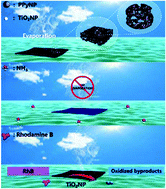A high-efficiency ammonia-responsive solar evaporator†
Abstract
The use of solar evaporators, which are capable of purifying water through solar energy, is a potentially attractive solution to relieve the world-wide water shortage problem. However, there may be toxic and volatile substances, such as ammonia, in water bodies, which could be evaporated along with water during the evaporation process, causing contamination of the purified water. In this work, we report an efficient ammonia responsive high-efficiency solar evaporator based on the titanium dioxide nanoparticle (TiO2NP) and polypyrrole nanoparticle (PPyNP) composite. Owing to the synergistic effect between the photo-induced hydrophilicity of the TiO2NPs and the photothermal effect of the PPyNPs, the solar evaporator is able to transport and evaporate water with an efficiency as high as 97.3% and an evaporation rate of 2.9 kg m−2 h−1 (under 2 sun irradiation). Interestingly, due to the ammonia responsiveness, the solar evaporator acts smartly and stops working in the presence of ammonia, thus avoiding the evaporation of this contaminant. In addition, the current solar evaporator is capable of degrading organic pollutants (e.g. dyes), which relies on the photocatalytic activity of TiO2NPs. We thus believe that the ammonia responsive solar evaporator reported in the current study may have great potential in the practical field.



 Please wait while we load your content...
Please wait while we load your content...